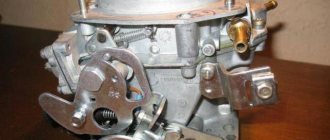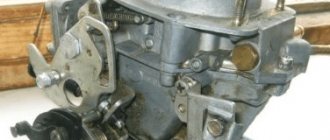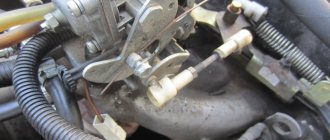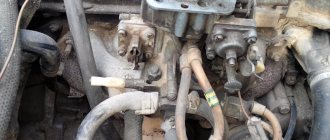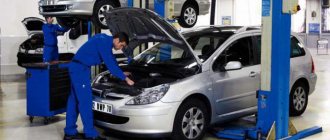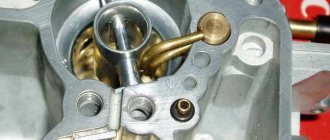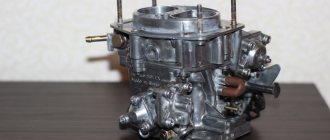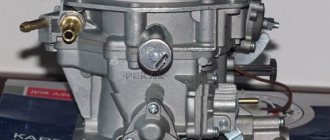Frequently encountered problems when pressing the accelerator pedal of a carburetor engine are the so-called “failure”, “jerk”, “twitching” and “swaying”.
A failure is when, when adding gas when starting or accelerating a car, sluggish engine operation is observed, a slow increase in speed up to a deceleration lasting from half a second to several seconds.
A jerk is the same failure, but shorter, up to half a second.
A twitch is a series of several jerks.
Swinging - several failures following one after another.
It is worth noting that before eliminating these malfunctions by changing the settings of the carburetor itself or disassembling it, you need to make sure that the reason lies precisely in it. The technical condition of the engine is of great importance. Incorrect installation of the gas distribution mechanism, wear of the camshaft, incorrectly set ignition, violation of compression in the cylinders: too low or unacceptably different in different cylinders. All this disrupts the normal operation of the engine, increases fuel consumption, and leads to clogging of the carburetor with deposits and resins.
It is also necessary to check the fuel supply system to the carburetor for blockages in the fine filter, the fuel pump strainer, the fuel intake, the tightness of the fuel pump, as well as the ignition system. At idle or at low loads, the engine can operate normally, but when the load increases, disturbances in the fuel supply may appear.
We will assume that the ignition, gas distribution, cylinder and fuel supply systems are fully operational and the reason lies in the carburetor. Let's consider the possible causes of dips and jerks in the Solex 21083 carburetor and ways to eliminate them:
Dips when starting
The outlet of the transition system is clogged.
Holes for Solex carburetor transition systems
The size of the holes can decrease over time due to deposits reducing fuel flow and leaving the mixture lean. To clean the holes in the transition systems, you will have to remove the carburetor, turn it over and clean it with a sharp stick or copper wire (it is impossible to clean the holes with anything harder than the carburetor material to avoid damaging the holes), rinse with acetone and blow out.
Low fuel level in the float chamber. This situation makes the fuel mixture leaner. To find out the fuel level in the chamber, let the engine run for a while, then remove the upper half of the carburetor and measure the fuel level, for example, with a caliper; for Solex 21083 the level should be 29 ± 1 mm. Gasoline tends to evaporate quickly, so remove the cap and take a measurement quickly. The needle valve may stick, thereby interfering with the flow of fuel into the float chamber; you can return the needle to its place by gently tapping, but it is better, of course, to replace it. If the fuel level is not correct, adjust the float mechanism.
Leaky tube supplying vacuum to the ignition vacuum corrector . Check the tube for cracks and breaks; the tube should fit tightly onto the appropriate fittings; replace the tube if necessary.
Location of Solex carburetor components
Dips and jerks when driving the car
The accelerator pump , econostat or economizer is faulty
The accelerator pump accounts for most of the problems associated with failure. As the name suggests, the function of the accelerator pump is to enrich the fuel-air mixture in all operating modes except idle.
The operation of the accelerator pump must be checked. To do this, remove the air filter and observe the streams of fuel from the nozzles in each of the chambers. When you press the pump lever, even streams will spray from both spouts, and they should not fall on the walls of the chambers. Experienced craftsmen take out the nozzle of the “elephant” accelerator pump and bend its tubes in such a way that the jets precisely fall into the gap between the chamber wall and the damper, and they must try to do this with the damper opening as small as possible. It is also necessary to take into account the thickness of the heat-insulating gasket under the carburetor; the jets should not touch its internal surfaces.
You should not try to improve the carburetor by bringing both spray tubes into the first chamber. In this case, mixture formation worsens and additional resistance to air flow appears in the first chamber, so such a modification will only worsen the performance of the carburetor. It would be more correct to replace it with a carburetor spray nozzle 21073-1107010 (for Niva) with one tube. If fuel jets are not observed, inspect the accelerator pump. On carburetors with a high mileage, it is possible that there may be wear in the area where the flag contacts the accelerator pump pusher, in which case parts will need to be replaced.
Check the accelerator pump diaphragm; if there is any doubt about its integrity, replace it. When assembling the pump, tighten the cap tightly.
However, when failures happen, it is not only the accelerator pump that is to blame
The econostat is designed to enrich the fuel mixture during operation at maximum load. Since the econostat is a tube built into the carburetor body, its repair comes down to washing and purging; it will be more convenient to do this by removing the upper half of the carburetor.
Econostat sprayer for Solex carburetor
Economizer - disturbances in the operation of the motor associated with the economizer of power modes are quite difficult to detect. But still check the diaphragm, the ball for jamming, the jets and channels - they should be clean.
Solex carburetor economizer
Blockages in the carburetor strainer or fine fuel filter . Unscrew the strainer nut, wash it, and replace it with a new one if necessary. Change the fine fuel filter.
The lower surface of the carburetor body is bent due to the excessive tightening of the nuts attaching to the intake manifold. The flange, which is attached to the intake manifold with four studs, is unfortunately the weak point of the carburetor. Over time, it bends, resulting in the formation of a gap into which additional air enters, leaning the mixture. This problem can be solved by leveling the bottom surface of the carburetor. But do not use a sandpaper file or a hammer for this purpose, you will damage the carburetor even more. It's better to contact a specialist. The leveling process is carried out in a special installation using high pressure. Another flange or a flat metal plate is placed on the surface of the flange, which aligns the carburetor parts due to pressure.
You can determine what exactly is causing the failure by the behavior of the engine in different modes.
- A deep dip, sometimes before the engine stops, can be caused by a clogged main fuel jet.
- Slight jerking when driving and sluggish acceleration - low fuel level in the float chamber.
- Rocking, dips and jerking at increased loads are disturbances in the fuel supply associated with the fuel pump, a clogged strainer, and a decrease in the throughput of the fine filter.
- A dip that appears and disappears after 2-5 seconds indicates a problem with the accelerator pump.
Like any other vehicle component, the fuel system will require repair under certain circumstances. Malfunctions of the Solex 21083 carburetor, as a rule, occur due to incorrect settings of the fuel system, low-quality fuel, operating conditions, etc.
A little about the Solex carburetor
Initially, VAZ equipped its cars with carburetors of the Weber family. These carburetors were completely mechanized. They lacked any electrical wiring and were not very reliable. Practically, they constantly needed attention, since the main struggle of car owners was aimed at returning the engine to idle speed. Only rear-wheel drive cars of the Zhiguli family VAZ 2101, 2103 and 2106 of the early versions were equipped with it.
“Weber” was replaced by “Ozone”, which began to be successfully used on VAZ 2105-07 cars. It was a perfect design, which was equipped with idle economizers and an autonomous system. The idle problem has been resolved. Ozone was also used on Niva cars.
With the advent of the front-wheel drive VAZ 2108 on the assembly line, a perfect design was required, aimed at reducing exhaust toxicity and maximizing fuel economy. This is how Solex was born.
Initially, it was a French design, which was purchased under license and was successfully installed not only on Samaras, but also on Zhigulis. Its design took into account all the mistakes of previous units, and efficiency increased to the limit. A properly tuned mechanism lasts a long time, and maintenance and repairs are cheaper than many modern cars. Unlike the Ozone family, it uses a long rod drive or cable, which significantly softens the accelerator pedal when depressed.
Almost all domestic carburetors are called DAAZ, and an index is written through a dash, the beginning of which corresponds to the car model.
Ozone or Solex
With the start of production of the VAZ 2108 and 2109, AvtoVAZ designers abandoned the use of Ozone carburetors, in which many complex options had no practical meaning. What was the cost of the forced idle economizer alone, which supposedly served to save fuel during engine braking? Neither engine braking became widespread, nor did the EPKH bring any noticeable savings, but it provided drivers with quite a few headaches when pressing the gas.
When switching to “eights” and “nines”, the plant returned to a simpler version of the carburetor. It was distributed under the name Solex: after the name of the French company that produced its prototype. Solex lost the pneumatic drive for the secondary chamber damper, a semi-automatic starting device, and an autonomous idle system.
The design has been simplified and reliability has increased. It is Solex that, as a rule, owners of carburetor versions of the VAZ 2109 deal with.
Why do dips appear when you press the gas sharply?
Classification of failures on the Solex 21083 carburetor:
- Short dip - the car does not respond to the gas pedal for about 2-3 seconds;
- Deep failure - the car does not respond to the pedal for about 10 seconds, sometimes stalls;
- Jerking – The car jerks every second and as the speed increases, the jerking stops.
Before considering the carburetor problem, it is necessary to remember that this can be influenced by a contaminated power system (air filter, fuel hoses and fine filter), as well as an ignition system that is not configured correctly. If you are sure that their operation is correct, then you can conclude that the carburetor is faulty.
The phenomenon itself may be due to a lean or too rich mixture that enters the cylinders. Further diagnostics depend on the symptoms of the malfunction and the problem can be eliminated at the lowest cost.
Signs of failure in the fuel system
The presence of possible malfunctions in the operation of the vehicle’s power system can be judged by the characteristic signs of the vehicle’s behavior on the road:
- Failure - while pressing the gas pedal, the car continues to move at the same speed (or deceleration) for a short period of time (from 1 to 30 seconds), and only after a while begins to pick up speed;
- A jerk is reminiscent of a failure, but it is more short-lived;
- Rocking - periodic failures;
- Twitching is several jerks that follow each other;
- Sluggish acceleration is a reduced rate of increase in vehicle speed.
In addition, you can judge the presence of malfunctions in the engine power supply system by the following signs:
- Increased fuel consumption;
- The engine does not start;
- Idle speed is reduced or increased;
- Difficulty in starting a hot/cold engine;
- Difficult operation of the car engine in cold mode.
Shift in gas distribution phases, wear on the camshaft cams, incorrect adjustment of heat clearances, reduced or uneven compression in the cylinders, as well as burnt valves significantly reduce the vehicle’s power, cause vibration and increase fuel consumption.
The carburetor and its malfunctions also play an important role. Let's look at the most common carburetor malfunctions using Solex as an example. How to properly clean, check and adjust the carburetor, using the VAZ 2109 as an example, is described in the article. So.
If the cylinder-piston group is worn out, then crankcase gases, oil vapors and tarry substances can enter the carburetor area, clog the filter element of the filter, and also settle on the jets and other elements of the carburetor, thereby disrupting the operation of the engine.
How to eliminate dips when you press the gas sharply?
There is nothing terrible in such a phenomenon. You can fight the reasons. Why this happens depends on how the fault manifests itself. We remove unnecessary symptoms and can find out why this happens when you press the pedal.
- Short failure . It usually appears when starting to move or smoothly accelerating. In both cases, the problem manifests itself when the gas pedal is gently pressed. The problem is contamination of the first chamber of the carburetor, but it can also affect the accelerator pump. This implies the operation of all transition systems that need to be checked. It is recommended to start repairs by cleaning the carburetor.
- Jerks . They appear when operating at medium speeds and smoothly pressing the accelerator pedal. The malfunction may disappear if you press the pedal sharply. A series of sharp pressure helps to restore speed and continue driving. Here the list can be significantly expanded, namely:
- The jet located in the dosing chamber is dirty;
- The jet is not fully screwed in;
- The jet marking does not correspond to the nominal value;
- “Suction” of excess air;
- The fuel level in the float chamber is too low or the valve is stuck;
- Check the diaphragm, it may be torn.
- Deep failure at high speed at medium crankshaft speeds. Accompanied by loss of power. The car does not reach maximum speed and “freezes” at medium speeds of the carburetor engine. The list of “culprits” is as follows:
- The throttle valve of the second chamber did not open;
- The fuel system filter element is dirty;
- Economizer malfunction;
- The econostat is damaged;
- The jets are dirty or not up to specification.
Still have a question? Watch the video from the famous carburetor Sergei Svetlov:
Carburetor or injector
While the whole world has made a choice in favor of injection engines, in our country the intensity of the debate on the topic “injector or carburetor” does not subside. Mostly, the debate revolves around the possibility of field repair of an engine with a carburetor or an injector. Adherents of the first passionately prove that a failed carburetor engine can be easily repaired literally “in the open field.” And if the injection engine fails, prepare a tow rope and go to the service center.
Proponents of injectors raise the objection that injection engines break down much less often, and there are only two typical malfunctions.
- Damage to the crankshaft position sensor.
- Fuel pump failure.
At the same time, the “injection guys” rather sarcastically clarify that the fuel pump can just as easily break down on a carburetor engine, and the sensor costs a penny and can be easily changed even in the field. Perhaps we should admit that the supporters of injection are somewhat right. But if you happen to drive a carburetor version, then you shouldn’t chase the illusory savings of a glass of gasoline per 100 kilometers. You shouldn’t start switching to a new type of power system just because the VAZ 2109 carburetor failed when you pressed the gas pedal.
If something happens, the carburetor “nine”, even if it sneezes in blue puffs, even with a sinking accelerator pedal, will take you home - after all, it’s worth something.
How to remove and clean a Solex 21083 carburetor?
To solve the problem, you need to start by cleaning the unit, which is located under the air filter. To do this, it must be removed from the car and completely disassembled. If necessary, carry out repairs with a special kit.
To do this, you need to unscrew the nut securing the air filter cover, unfasten the cover and remove the filter element. Remove all hoses from the body and unscrew the mounting nuts from the carburetor. Next, you need to remove the body and disconnect all the damper rods from the carburetor to free it from all the holding moving elements. These include hoses.
The last step is to remove the carburetor itself. To do this, unscrew the four fastening nuts and remove the unit from the car. If this is difficult, then carefully pry it off with a thick flat-head screwdriver and generously lubricate the perimeter with WD40. It can only be removed with sudden movement.
After removal, the carburetor is completely disassembled and smoothly cleaned using kerosene, gasoline or special products for cleaning throttle valves. All elements and channels must be wiped dry, and faulty parts should be replaced with a repair kit. Now you can reassemble in reverse order, place it on the engine and fully adjust. If you have any questions about removing and cleaning the Solex 21083 carburetor, I recommend reading the review article on our website, here it is.
Marking of Solex carburetor jets
| Carburetor designation | Econostat jet | Pneumatic drive jet | Starter damping jet | Throttle openings at start-up (dimension A), mm | Slight opening of the air damper with the starting device (size B), mm | Fuel level in the float chamber | ||
| 2101-1107010 | 150 | 90 | 170 | 70 | 0.75-0.85 | 7±0.25 | 7±0.25 | |
| 2101-1107010-02 | 150 | 90 | 170 | — | 70 | 0.75-0.85 | 7±0.25 | 7±0.25 |
| 2101-1107310-03; 2101-1107010-30 | 150 | 120 | 150 | — | 70 | 0.75-0.85 | 7±0.25 | 6.5±025 |
| 2103-1107010 | 180 | 120 | 160 | 70 | 0.8-0.9 | 7±0.25 | 7±0.25 | |
| 2103-1107010-01; 2106-1107010 | — | — | — | — | 70 | 0.8-0.9 | 7±0.25 | 6.5±0.25 |
| 2105-1107010-10 | 150 | 120 | 150 | 120 100 | 70 | 3.7-0.9 | 5±0.5 | 6.5±0.25 |
| 2105-1107010; 2105-1107010-20 | 150 | 120 | 150 | 120 100 | 70 | 0.5-0.8 | 5±0.5 | 6.5±0.25 |
| 2107-1107010; 2107-1107010-20 | 150 | 120 | 150 | 150 120 | 70 | 0.9-1.0 | 5.5±0.25 | 6.5±0.25 |
| 2107-1107010-10 | 160 | 120 | 150 | 150 120 | 70 | 0.9-1.0 | 5.5±0.26 | 6.5±0.25 |
| 2108-1107010 | 60 | — | — | — | — | 0.85 | 3±0.2(bottom) | 25.5±1.0 (remainder) |
This is how problems with dips that accompany pressing the gas pedal are solved. It’s easy to guess that the problem can be solved in a garage, which is why it’s not necessary to go to a specialized service center.
VAZ 2109 carburetor malfunctions
The carburetor is one of the most delicate components of the VAZ 2109 car to configure. Its repair requires experience. The maximum that an amateur can handle is replacing the throttle cable of a VAZ 2109. Many subtle technologies interact with each other in the process of preparing the air-fuel mixture. By adjusting the operation in acceleration mode, you risk disrupting the idle speed adjustment, and vice versa. So you should start repairing the carburetor yourself with caution and without excessive self-confidence.
A significant volume of fuel with all impurities, chemical and mechanical inclusions, conceivable and inconceivable contaminants passes through the carburetor. This means that cleaning will never harm the carburetor. It is about total cleaning that we will talk about.
Everything is cleaned, including fuel injectors, air jets, transition channels, filter elements and metering wells. This is done like this:
- disconnect the mechanical throttle actuator;
- separate the inlet and outlet fuel pipes;
- wrap the freed carburetor with aluminum foil of sufficient width;
- place the wrapped carburetor in a plastic bucket to protect it from leaking;
- fill the carburetor with acetone or other strong solvent;
- leave the carburetor in a flooded state for a day.
Keep in mind that this should be done in a well-ventilated non-residential area. At the end of washing, drain the solvent, rinse the unit with a running stream of solvent, blow with a stream of compressed air, and dry. Install the carburetor in its original place. Try your "nine".
If a radical flush solves the problem, ride to your heart's content. If you haven’t decided, it’s time to turn to professionals. Forget about engine failures for a while and go to a car service center.
Solex 21083 on classic. Dips. — DRIVE2
The essence of the problem:
short dip when pressing the gas quickly (starting off, after changing gears, after changing engine braking to acceleration). This means the quick opening of the first chamber from 1/3 or more, and not when “slippers hit the floor”. The failure is accompanied by a short-term thoughtfulness of the car on universal themes, then inspiration comes, and it rushes off like crazy. Needless to say, this behavior of the iron horse is incredibly annoying, especially in the urban cycle.
Search for truth.
It was decided to start by replacing the EKXX fuel nozzle with a smaller one. Initially it was set at 42. At 40 - a little better; at 38 - a little more; ignition earlier is a little better; a richer mixture... Result: the same nonsense, but with a different sauce. The overall improvement in the picture is extremely negligible, plus we have too early ignition (sea trials showed). By the way, a simple way to determine the correct setting of the ignition timing on the go: on a horizontal, flat and clean section of the road at a speed of 50 km/h in 4th gear, put the gas to the floor and listen (coolant temperature 90 degrees, tires inflated, good gasoline). 1) If a booming low engine sound accompanies acceleration, it means late ignition; 2) if you hear constant detonation (a loud knock) - early ignition. 3) if short-term detonation is replaced by a booming sound during acceleration - everything is ok.
So, let's dig further. Replacing the EKXX with a new one, then a used one, didn’t give anything either. Replacing spark plugs, explosive wires, distributor cap (BSZ installed), switch, gas station - similarly did not bring success.
Solution.
Adjusting the “kettle” in the carburetor. Firstly, transfer both spouts to the first chamber (why would it pour onto the closed valve of the second chamber). Secondly, adjusting the jet so that it hits exactly the gap between the chamber wall and the slightly opening damper of the first chamber. As close to the chamber wall as possible. And so that the streams do not intersect. Vroom-vroom)))
Difficulty starting the engine and fuel consumption
_Difficulty starting a cold engine_ can be caused by incorrect adjustment of the starting mechanism. Partially closing the air damper can cause the mixture to become leaner, which in turn will cause a lack of sparks in the cylinders, and opening it incorrectly after starting the engine enriches the mixture quite richly, so the engine “chokes.”
_Difficulty starting a car when the engine is warm_ can be caused by the fact that a rich mixture enters the cylinders due to the high level of fuel that is in the float chamber. The reason for this may be a maladjustment of the fuel chamber or the fuel valve is not sealed well enough.
